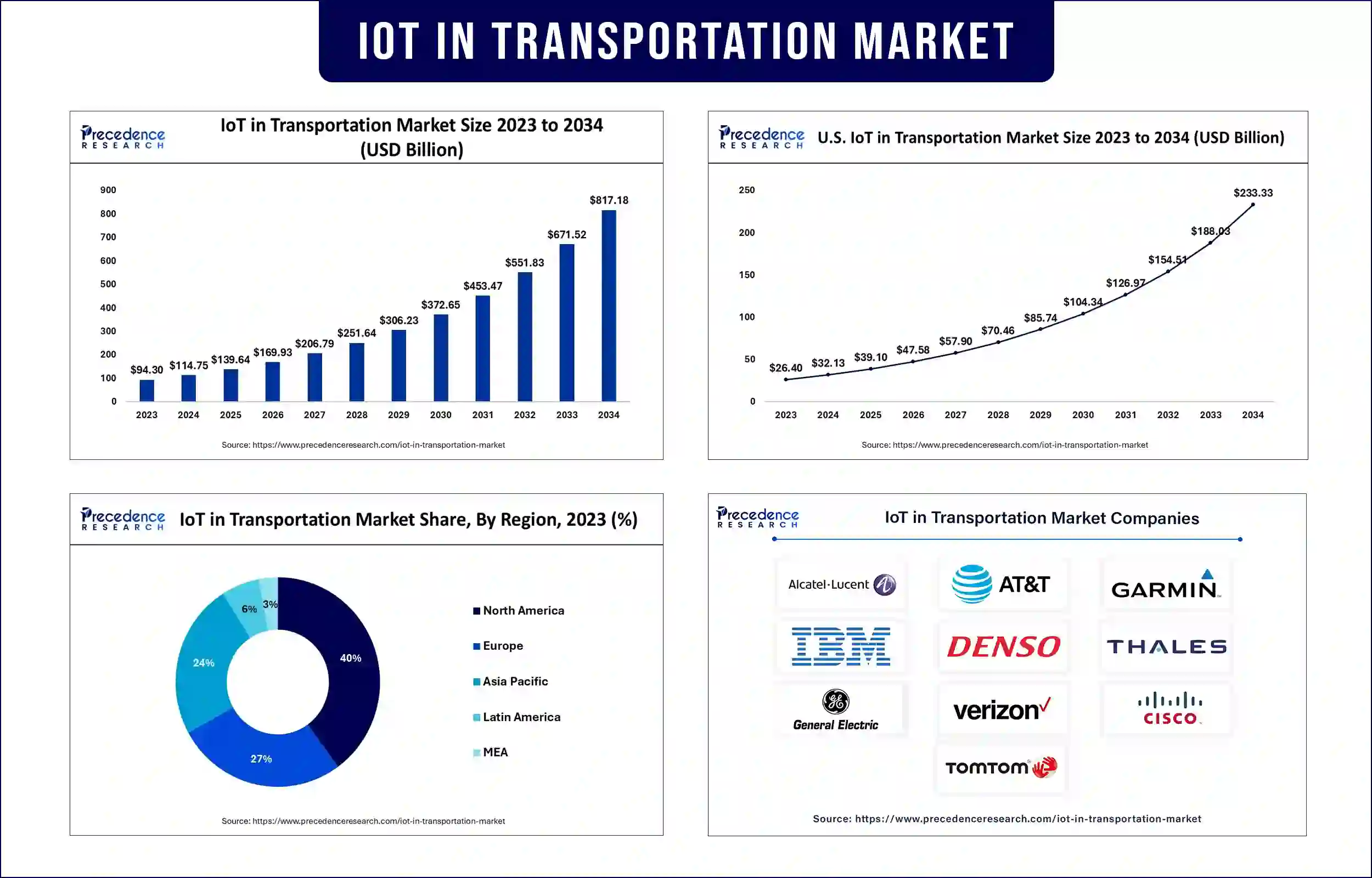IoT In Transportation Market Revenue to Attain USD 671.52 Bn by 2033
IoT In Transportation Market Revenue and Trends
The global IoT in transportation market size was estimated at USD 114.75 billion in 2024 and is predicted to attain around USD 671.52 billion by 2034, expanding at a compound annual growth rate (CAGR) of 21.69% during the forecast period 2024 to 2033. The rising adoption of IoT devices in the transportation sector to streamline logistic operations is expected to boost the market in the coming years. Moreover, the availability of powerful sensors and controllers, ongoing technological advancements, and an increase in the utilization of cloud computing and analytics fuel the growth of this market.

Market Overview
The Internet of Things (IoT) refers to the networking of devices and machines. The IoT technology has a number of applications in various industries like electronics, automotive, industrial, retail, and transportation. The Internet of Things (IoT) for transportation consists of networking tools and machinery using embedded actuators, sensors, and other devices that help collect data on actual activities. The transportation industry is evolving as a result of the use of IoT-enabled technology. With the use of IoT technology, it is easy to measure train speeds, roadway temperatures, the number of vehicles at an intersection, aero plane parts conditions, and many more. The rising development of information, communication, and technology (ICT) and the growing concerns about traffic are expected to contribute to market expansion.
Highlights of the IoT in Transportation Market Report
- On the basis of source, the hardware segment dominated the market in 2023. This is mainly due to hardware’s key role in carrying out an array of different functions, such as gathering, processing, and analyzing data from various devices. IoT hardware encompasses a wide range of gadgets, including sensors, bridges, and routing devices, which control important processes and features such as system activation, security, action definitions, communication, and the detection of support-specific objectives and actions. IoT hardware is the core of IoT systems.
- Based on transport, the airways segment dominated the market in 2023 and is poised to grow steadily in the near future, owing to the rising air traffic. IoT devices help maintain the aircraft's safety and improve the passengers' traveling experience. They also help in baggage monitoring and cabin climate management and provide emergency alerts. On the other hand, the railways segment is anticipated to expand at the fastest rate during the forecast period. IoT in railways involves the use of smart devices such as cameras, digital signs, and temperature and vibration sensors. These devices help improve passenger safety, operational efficiency, and the passenger experience.
IoT In Transportation Market Trends
- Technological advancements: The inclusion of cloud computing, IoT technologies, and analytics in the transportation sector has been on the rise due to rising technological advancements. These technologies help the transportation sector to advance its infrastructure and reduce operational expenses. Ongoing technological advancements like robotics, self-driving vehicles, communication solutions, and wireless technologies are expected to revolutionize the IoT in the transportation market.
- High demand for IoT devices: The demand for IoT devices is rising in the transportation sector, as they help track vehicles' locations in real-time. IoT technology can make transportation operations safer for passengers and drivers.
- Expansion of rail network: The railway network is expanding rapidly due to the growing need for urban connections. IoT is frequently utilized in the railway sector to monitor passenger flow, manage timetables, maximize capacity, and perform preventative maintenance.
IoT In Transportation Market Coverage
| Report Attribute | Key Statistics |
| Market Revenue in 2024 | USD 114.75 Billion |
| Market Revenue by 2033 | USD 671.52 Million |
| CAGR | 21.69% from 2024 to 2033 |
| Quantitative Units | Revenue in USD million/billion, Volume in units |
| Largest Market | North America |
| Base Year | 2023 |
| Regions Covered | North America, Europe, Asia-Pacific, Latin America, and Middle East and Africa |
Regional Insights
North America dominated the IoT in transportation market with the largest share in 2023. This region has a well-established transportation & logistics sector and advanced technologies, which are key reasons supporting the region’s dominance. In addition, government regulations about passenger and vehicle safety and the adoption of cutting-edge technologies further bolstered the market in North America. For instance, the National Traffic and Motor Vehicle Safety Act imposes safety standards to protect the public from unreasonable risk of accidents due to the design, construction, or operation of automobiles.
The market in Asia Pacific is expected to expand at the highest CAGR during the forecast period. There is a rising demand for IoT devices in the transportation sector in this region due to the increasing emphasis on passenger safety. With IoT, managing traffic, ticketing and toll systems, real-time updates, surveillance systems, and remote monitoring of vehicles are possible. Moreover, rising concerns about traffic congestion in countries like India and Japan contribute to regional market expansion.
Market News
- In January 2023, AT&T Inc. partnered with Geotab, a global leader in IoT and connected vehicles. The main motive behind this partnership was to reduce drive emissions in the transportation sector by combining Geotab's award-winning telematics solutions with AT&T's Internet of Things (IoT) platforms.
IoT In Transportation Market Market Players
- Alcatel-Lucent
- AT&T Inc.
- Garmin International Inc.
- IBM Corp.
- Denso Corp.
- Thales Group
- General Electric
- Verizon Communications Inc.
- Cisco Systems, Inc.
- TomTom N.V.
Market Segmentation
By Source
- Hardware
- Software
- Services
By Components
- Semiconductor
- Wireless
- Others
By Transport
- Roadways
- Railways
- Airways
- Maritime
By Application
- Traffic Congestion Control Systems
- Automotive Telematics
- Reservation, Toll, & Ticketing Systems
- Security & Surveillance Systems
- Remote Monitoring
- Others
Buy this Research Report@ https://www.precedenceresearch.com/checkout/2003
You can place an order or ask any questions, please feel free to contact at sales@precedenceresearch.com| +1 9197 992 333